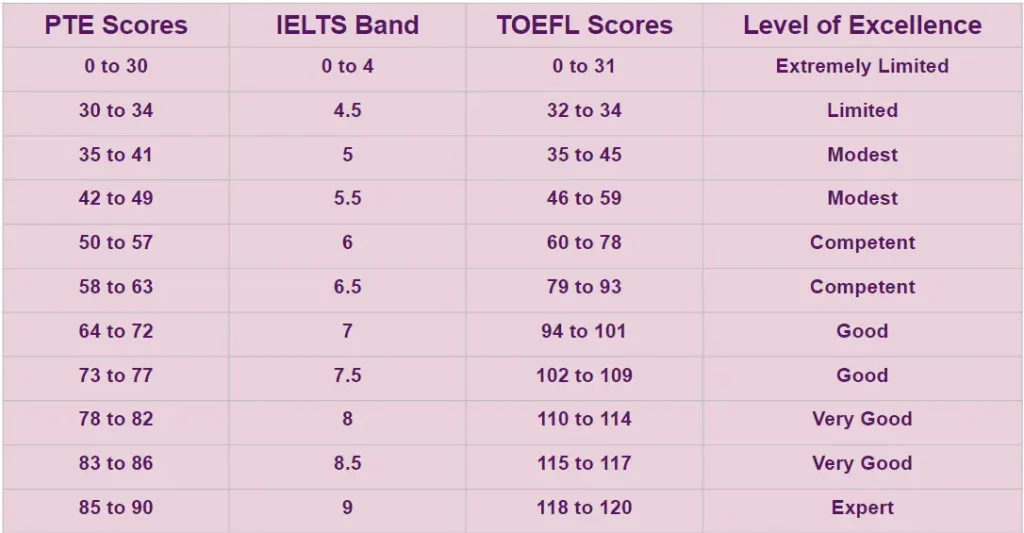What is PTE?

Speaking and Writing (combined)
Engage in a comprehensive evaluation of your expressive abilities with the combined Speaking and Writing module. This segment challenges you to articulate your thoughts coherently and expressively, showcasing your proficiency in both spoken and written English. Navigate through diverse tasks that measure your ability to convey ideas, respond to prompts, and structure written responses effectively.
Listening Module
Immerse yourself in the nuances of auditory comprehension with the PTE Listening module. This segment evaluates your capacity to decipher spoken English across various accents and contexts. Navigate through a series of audio recordings, demonstrating your skill in understanding main ideas, details, and nuanced information – essential for success in academic and real-world scenarios.
Reading Module
Unravel the complexities of written texts in the PTE Reading module, where diverse passages test your comprehension skills. From articles and essays to infographics, this segment evaluates your ability to interpret information, identify key ideas, and draw inferences. Sharpen your reading prowess as you navigate through a spectrum of written materials, showcasing your proficiency in handling diverse textual formats.
Significance of PTE:

- Study Abroad: Numerous universities and educational institutions in English-speaking countries, such as the United States, the United Kingdom, Australia, and Canada, acknowledge PTE scores as evidence of English proficiency for admission to academic programs.
- Immigration: Certain countries incorporate PTE scores in their immigration processes to evaluate the English language proficiency of individuals seeking work opportunities or permanent residency.
- Employment:Employers across various industries may utilize PTE scores to gauge English language proficiency, particularly in roles where effective communication is paramount.
- Professional Recognition:Professional bodies and licensing authorities may accept PTE scores for evaluating language skills in specific occupations.
PTE Score Range:
The PTE Academic score ranges from 10 to 90 and is determined by assessing language skills in three categories:
– Speaking and Writing (combined)
– Listening
– Reading
Each category receives an individual score, and the overall score is the sum of these three section scores.
Score Range:
Which countries do accept PTE?

PTE (Pearson Test of English) scores are accepted by thousands of universities, colleges, governments, and organizations worldwide as proof of English language proficiency for academic, employment, or immigration purposes. Some of the countries that accept PTE scores include:
- Australia: PTE scores are widely accepted by universities and colleges in Australia for admission to undergraduate and postgraduate programs.
- United Kingdom: Many universities and colleges in the UK accept PTE scores for admission to academic programs, including undergraduate and postgraduate degrees.
- United States: Several universities and colleges in the United States recognize PTE scores for admission purposes, particularly for international students applying for undergraduate or graduate programs.
- Canada: PTE scores are accepted by many Canadian universities and colleges as proof of English language proficiency for admission to academic programs.
- New Zealand: Universities and colleges in New Zealand accept PTE scores for admission to undergraduate and postgraduate programs.
- Singapore: PTE scores are recognized by educational institutions in Singapore for admission purposes, including universities and polytechnics.
- Ireland: Many universities and colleges in Ireland accept PTE scores for admission to academic programs at undergraduate and postgraduate levels.
- European Union: Some universities and educational institutions in European Union countries, such as Germany and France, accept PTE scores for admission to certain programs taught in English.
- India: Several universities and educational institutions in India accept PTE scores for admission to undergraduate and postgraduate programs.
- Other Countries: PTE scores are also accepted in countries such as Malaysia, South Africa, the Philippines, and many more.
It’s important for test takers to verify the specific English language proficiency requirements of their intended institutions or organizations, as acceptance of PTE scores may vary depending on individual policies and program requirements.

